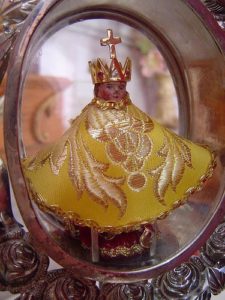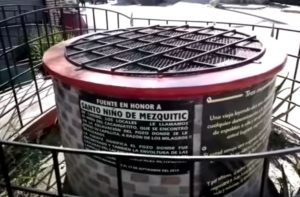Podcast: Play in new window | Download
Subscribe: Apple Podcasts | RSS
 In the dry dusty highlands of the state of Jalisco, just north of Guadalajara, a community called Mezquitic de la Magdalena has existed since before the arrival of the Spanish. No one knows the exact meaning of the word “Mezquitic” but it originates from the Tecuexe language which saw its last speaker walk the earth sometime in the 1850s. The completely Mexicanized descendants of the Tecuexe still live in this town of less than two thousand people today. Besides DNA there is very little linking the current residents to their colorful past. This sleepy town is not completely under the radar, though, at least not to the deeply religious. Devout Mexican Catholics know this place as the home of the third most visited holy shrine in the state of Jalisco, behind the basilicas devoted to the Virgins of Zapopan and San Juan de los Lagos, respectively. For more information about these other major shrines, please see Mexico Unexplained episodes number 56 and 28. https://mexicounexplained.com//842-2/ https://mexicounexplained.com//miracles-virgin-san-juan-de-los-lagos/ Even though the town is a mere 10 miles from the shrine of the Virgin of San Juan de los Lagos, just 5 minutes on a modern road, many people throughout Mexico and even in the larger cities of Jalisco have never heard of the biggest draw to Mezquitic de la Magdalena: The Shrine to the Santo Niño del Cacahuatito. In English this translates to, Holy Child of the Little Peanut.
In the dry dusty highlands of the state of Jalisco, just north of Guadalajara, a community called Mezquitic de la Magdalena has existed since before the arrival of the Spanish. No one knows the exact meaning of the word “Mezquitic” but it originates from the Tecuexe language which saw its last speaker walk the earth sometime in the 1850s. The completely Mexicanized descendants of the Tecuexe still live in this town of less than two thousand people today. Besides DNA there is very little linking the current residents to their colorful past. This sleepy town is not completely under the radar, though, at least not to the deeply religious. Devout Mexican Catholics know this place as the home of the third most visited holy shrine in the state of Jalisco, behind the basilicas devoted to the Virgins of Zapopan and San Juan de los Lagos, respectively. For more information about these other major shrines, please see Mexico Unexplained episodes number 56 and 28. https://mexicounexplained.com//842-2/ https://mexicounexplained.com//miracles-virgin-san-juan-de-los-lagos/ Even though the town is a mere 10 miles from the shrine of the Virgin of San Juan de los Lagos, just 5 minutes on a modern road, many people throughout Mexico and even in the larger cities of Jalisco have never heard of the biggest draw to Mezquitic de la Magdalena: The Shrine to the Santo Niño del Cacahuatito. In English this translates to, Holy Child of the Little Peanut.
The story of the Santo Niño begins on the eve of Mexican independence, in the year 1810. Pedro Alanís and Juana Gallardo had very little water on their property and often asked their neighbors for water in times of drought. Their neighbors got tired of always helping them out and one of them told Pedro to leave everyone alone and dig a well. Pedro knew his land would probably not yield much water, so he and his wife prayed to the Virgin of Guadalupe to give them a sign on where to dig. Along with those prayers for dowsing advice, according to the story, the couple also prayed that their neighbors would be more charitable toward others in the future. In the ensuing days Pedro wandered his property looking for a sign. While out one afternoon he noticed an unusually healthy and green young tree which he had never seen before. At the base of the tree the ground was somewhat damp. It was here where he would dig his well. Pedro went to his neighbors to ask for assistance and they were eager to help him. This was encouraging to him because part of his prayer was to have his neighbors’ hearts soften to the idea of giving help. With enthusiasm, a group of village men began to dig the well. They would eventually hit an overabundance of water, but about 10 feet down they found something curious in the dirt. It was a figure of a baby measuring about 4 inches long and 2 inches wide. It was made of mud and wood, with one arm resting on its chest and one arm resting on its belly. It was devoid of clothing but had delicate features on its face, including eyelashes. Some insist that this is a small devotional item from the time of the Tecuexes made centuries before the Spanish arrived, possibly a representation of a god or natural spirit. How it ended up so deep in the earth is unknown. Perhaps it was intentially buried for some ceremonial purpose. Others faithfully believe that it is a small Christ Child and it is responsible for the miracle of bringing the neighbors together and for providing water in a time of dire need.
Pedro and Juana were among the faithful. They cleaned up the tiny statue and dressed it up in fancy clothing. They put it on the small altar inside their home along with other devotional objects. It wasn’t long before word spread throughout the town of this curious discovery and people came knocking at the door of Pedro and Juana’s home. The couple opened their humble house to those wishing to see what would be soon called the Santo Niño de Mezquitic. People seeking miraculous interventions in their lives also came for the well water. The crowds grew and within their lifetimes Pedro and Juana received returning pilgrims who told them of the many miracles attributed to praying to the statue or to drinking or otherwise using the water from their well. Because the town of Mezquitic de la Magdalena is so close to the Basilica of the Virgin of San Juan de los Lagos, the Alanís-Gallardo home became a short stopover for San Juan devotees. The crowds grew over time.
 In 1884, the small Santo Niño statue was moved. That year a small chapel was built in the town dedicated to the Virgin of Guadalupe and this became the sculpture’s new home. That same year, the Archbishop of San Juan de los Lagos, Pedro Loza y Pardavé intervened and declared that the statue was not officially miraculous in the eyes of the Catholic Church and neither was the water from the well. One of the problems the Archbishop had with the statue was that it was too small, about the size of a peanut. The archbishop was afraid that devotion to this Santo Niño was turning into a cult and taking people away from the real officially sanctioned worship that should have been happening at the basilica. Nothing could stop the pilgrims from coming, however, and the primary focus of the new Guadalupe chapel became this unusual tiny statue which visitors now affectionately called El Santo Niño del Cacahuatito, or the Holy Child of the Little Peanut, due to its size. The caretakers of the Guadalupe chapel took special care of this miraculous statue. They topped it with a golden crown and dressed it up in a fancy flaring yellow robe. Most people not familiar with Mexico’s take on Catholicism might think it strange that the Baby Jesus looks like a pretty little girl in an elegant party dress, but this is the custom, as seen with many Santo Niño statues throughout the country. In addition to the fine stitchery, the statue is housed in an ornate oval silver nicho surrounded in delicately hand-fashioned silver roses. This oval nicho sits atop a shiny silver base that looks somewhat like a championship sports trophy. The elaborate silver nicho is kept in a glass box flanked with small twisting pillars carved of wood and rests on a wooden base flanked with cherub heads. This display case is located beneath the statue of the Virgin of Guadalupe in the part of the chapel where an altar normally would be located. Visitors can get within inches of the glass to see the small slouchy figure inside the display case. The Baby Jesus appears to have a rather drowsy expression on his delicate face, despite his rosy cheeks. The statue never leaves the shrine and it is not paraded through the streets as devotional figures often are in Mexico. There are two dates on the ecclesiastical calendar that have special celebrations centered around the Santo Niño in Mezquitic. These are February 1st on the Eve of the Catholic holiday Candlemas, and also on September 17th.
In 1884, the small Santo Niño statue was moved. That year a small chapel was built in the town dedicated to the Virgin of Guadalupe and this became the sculpture’s new home. That same year, the Archbishop of San Juan de los Lagos, Pedro Loza y Pardavé intervened and declared that the statue was not officially miraculous in the eyes of the Catholic Church and neither was the water from the well. One of the problems the Archbishop had with the statue was that it was too small, about the size of a peanut. The archbishop was afraid that devotion to this Santo Niño was turning into a cult and taking people away from the real officially sanctioned worship that should have been happening at the basilica. Nothing could stop the pilgrims from coming, however, and the primary focus of the new Guadalupe chapel became this unusual tiny statue which visitors now affectionately called El Santo Niño del Cacahuatito, or the Holy Child of the Little Peanut, due to its size. The caretakers of the Guadalupe chapel took special care of this miraculous statue. They topped it with a golden crown and dressed it up in a fancy flaring yellow robe. Most people not familiar with Mexico’s take on Catholicism might think it strange that the Baby Jesus looks like a pretty little girl in an elegant party dress, but this is the custom, as seen with many Santo Niño statues throughout the country. In addition to the fine stitchery, the statue is housed in an ornate oval silver nicho surrounded in delicately hand-fashioned silver roses. This oval nicho sits atop a shiny silver base that looks somewhat like a championship sports trophy. The elaborate silver nicho is kept in a glass box flanked with small twisting pillars carved of wood and rests on a wooden base flanked with cherub heads. This display case is located beneath the statue of the Virgin of Guadalupe in the part of the chapel where an altar normally would be located. Visitors can get within inches of the glass to see the small slouchy figure inside the display case. The Baby Jesus appears to have a rather drowsy expression on his delicate face, despite his rosy cheeks. The statue never leaves the shrine and it is not paraded through the streets as devotional figures often are in Mexico. There are two dates on the ecclesiastical calendar that have special celebrations centered around the Santo Niño in Mezquitic. These are February 1st on the Eve of the Catholic holiday Candlemas, and also on September 17th.
 The devotion to this sculpture was mostly local until 100 years after the Santo Niño was gussied up and given a permanent home. The veneration of the Baby Jesus of the Little Peanut has increased tremendously since 1985, when the priest Maximino Rodríguez arrived at the parish of Sangre de Cristo in Mezquitic de la Magdalena and decided to remodel the chapel and promote worship. In 1993, Father José Inés Rodríguez appointed Francisco Padilla de Luna to be in charge of the chapel, who through photographs promoted the image by calling it the more endearing El Niño del Cacahuatito.
The devotion to this sculpture was mostly local until 100 years after the Santo Niño was gussied up and given a permanent home. The veneration of the Baby Jesus of the Little Peanut has increased tremendously since 1985, when the priest Maximino Rodríguez arrived at the parish of Sangre de Cristo in Mezquitic de la Magdalena and decided to remodel the chapel and promote worship. In 1993, Father José Inés Rodríguez appointed Francisco Padilla de Luna to be in charge of the chapel, who through photographs promoted the image by calling it the more endearing El Niño del Cacahuatito.
Today, thousands of parishioners from all over Mexico and from abroad worship him. In León, in the neighboring state of Guanajuato, religious pilgrimages are organized to the area that include a visit to the Niño del Cacahuatito. One can enter the small chapel to visit the tiny statue and sit in the pews reserved for contemplation and prayer. Beside the glass cubicle home of the Baby Jesus figure people often leave toys and other gifts of thanks for prayers answered or miracles performed. This is only a small taste of the great devotion this shrine exudes. Off to the left of the statue the chapel has two rooms. These rooms are reserved for objects left by pilgrims. The walls from floor to ceiling are covered with small tokens of thanks left behind by the devout. Because many people pray to the Niño del Cacahuatito for intercessions in the lives of children there are many articles related to children in this part of the chapel. Toys, clothing and devotional paintings called ex votos describing miracles hang somberly on the walls. There are also several designated areas on which the faithful can pin tiny metal charms called milagros to pray for a miracle or to give thanks for a miracle received. For more information on milagros, please see Mexico Unexplained episode number 1. https://mexicounexplained.com//the-magic-of-milagros/
 A pilgrimage stop at Mezquitic de la Magdalena also includes a visit to the sacred well. There is the original brick-lined well that Pedro Alanís and his neighbors built back in 1810 now covered with a metal grate. Near the old well is a larger and more modern pump that extracts water from the original source. The caretakers of the shrine and volunteers make water available for free in large barrels. Visitors can come with little bottles and fill their containers by dipping pitchers into the barrels. Donations are accepted, but not required. There is also a legend involving coins. Visitors to the well are supposed to throw three coins in the sacred well. One coin will ensure a return to the town. The second one is for finding true love. The third one is so that the person making the wish would one day live in the town. Outside the shrine and the well area vendors sell the typical Mexican devotional items found at most shrines, and trinkets and images specific to the tiny Christ sculpture. This place, though, has something unique to it not found at any other Mexican religious shrine, or perhaps anywhere else in the world of holy places: Sacred peanuts! Because peanuts are grown locally and the object of devotion is nicknamed the Baby Jesus of the Little Peanut, it was only a matter of time before an enterprising local started selling bags of nuts and calling them miraculous. There is a myth that the tiny statue was found inside a peanut shell, but according to the generally accepted story of the sculpture’s discovery, this was not the case.
A pilgrimage stop at Mezquitic de la Magdalena also includes a visit to the sacred well. There is the original brick-lined well that Pedro Alanís and his neighbors built back in 1810 now covered with a metal grate. Near the old well is a larger and more modern pump that extracts water from the original source. The caretakers of the shrine and volunteers make water available for free in large barrels. Visitors can come with little bottles and fill their containers by dipping pitchers into the barrels. Donations are accepted, but not required. There is also a legend involving coins. Visitors to the well are supposed to throw three coins in the sacred well. One coin will ensure a return to the town. The second one is for finding true love. The third one is so that the person making the wish would one day live in the town. Outside the shrine and the well area vendors sell the typical Mexican devotional items found at most shrines, and trinkets and images specific to the tiny Christ sculpture. This place, though, has something unique to it not found at any other Mexican religious shrine, or perhaps anywhere else in the world of holy places: Sacred peanuts! Because peanuts are grown locally and the object of devotion is nicknamed the Baby Jesus of the Little Peanut, it was only a matter of time before an enterprising local started selling bags of nuts and calling them miraculous. There is a myth that the tiny statue was found inside a peanut shell, but according to the generally accepted story of the sculpture’s discovery, this was not the case.
We are still left with a series of mysteries around the Santo Niño’s true origins and age. Was it a tiny indigenous idol or offering buried for a specific purpose and never to be unearthed? Was it a hoax, something created by the townsfolk to increase tourism and trade in the area? Or was it a true miraculous manifestation of the Christ Child appearing in a time of need and to reassure the faithful? Whatever the answers to these questions may be, the devotion to the Baby Jesus of the Little Peanut continues to increase and tens of thousands of people believe in his miracles.
REFERENCES
mexicodesconocido website (in Spanish)
visitajalisco website (in Spanish)
